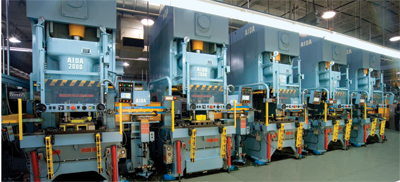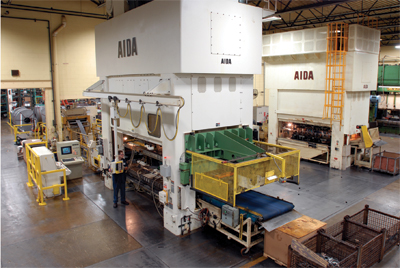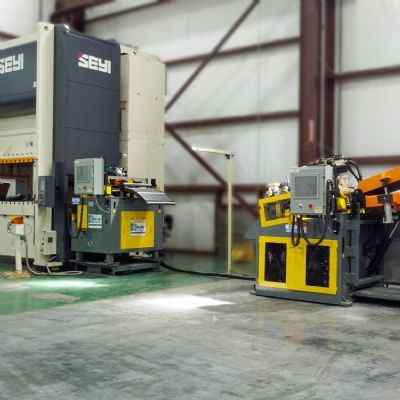Design for Flexibility Optimizes Uptime
A stamper’s ability to achieve high machine-uptime rates is equally important to becoming more competitive. A recent article from Reuters states, “Manufacturers can reduce costs by anywhere from two to 10 percent by cutting scrap and factory downtime and taking waste out.”
Machine flexibility—a press that can produce a wide range of parts—and capabilities such as QDC and fast part-to-part changeover—can improve uptime. Stampers should aim for a machine-uptime rate of 70 percent or more—this means actual cycling of the press to produce parts and does not include QDC, part changeover or other ancillary processes. And today, QDC systems allow metalformers to change dies in a matter of minutes.
However, proper use of QDC and other means to achieve fast part-to-part changeover requires the stamper to consider the entire
 |
| Transfer lines—this one comprised of servo-driven gap presses—help stampers minimize costs and run lean. Photo courtesy Newman Technologies S.C. |
For progressive-die press operations, coil-handling systems offer numerous opportunities to improve uptime. The use of coil cars and double dereelers is a good place to start. Follow this by adding a threading table and a programmable control that allows for the storage of setup parameters for the entire feed line, and a stamper is well on its to improving machine uptime.
Quick Tips for Dispensing of Downtime
Once a new strip has entered the die, having a strip start mark on the die block can save time and avoid die damage. Also, during die design, the designer should account for automatic threading in continuous mode, a feature that can save many minutes of downtime.
In transfer-die and press-to-press transfer systems, using the proper blank-feeding device can increase productivity by sensing and correcting double-blank misfeeds and reloading the blank feeder without requiring the operator to stop the press. The blank feeder should automatically discharge extra blanks upon double-blank detection. Blank-hold devices allow a few blanks to be automatically held while the next blank stack moves into position. This also eliminates the need for the operator to stop the press when the blank supply runs low.
Stampers also can set up a data-bank program in the system controller that houses all of the machine settings for each part to be run, which will raise productivity by allowing quicker part-to-part changes.
A servo-transfer or coil-feed mechanism allows a press to change motion profiles for the transfer pitch, the bar-clamp motion and lift motion. Or, with a coil feed, the progression as well as the acceleration and deceleration of the material in the feed cycle can be changed.
An electronic servo-transfer or coil-feed mechanism can deliver increased production speeds and greater efficiency because all feed profiles can be adjusted and retimed for each part or job to achieve optimal operating speed. In addition, once job programs have been written, they can be stored, eliminating the need to constantly reprogram the press.
Servo Technology: Reduce Rejects, Slash Energy Costs
Stampers also can leverage press technology to minimize offal, by producing parts close to specification. Servo-drive presses give the stamper fully programmable slide motion and adjustable stroke length, which can reduce reject rates by allowing stampers to form parts from material that would normally carry a high reject rate. In addition to controlling the amount of scrap generated, the nearly limitless number of s stroke, velocity and dwell profiles can be programmed and combined provides the flexibility to quote jobs stampers may not have considered in the past.
Energy savings also come with the investment in servo technology. Operating costs are reduced with a high-capacity capacitor bank circuit. Huge capacitors store energy when the servo motor is not under load, and when the motor is loaded, power draws from the capacitors and not the main line. As a result, power consumption often is less than that of a standard mechanical press. Depending on the part produced, a stamper can expect to achieve energy savings of 30 to 50 percent. MF
View Glossary of Metalforming Terms
See also: Aida-America Corp.
Technologies: Stamping Presses










 Video
Video